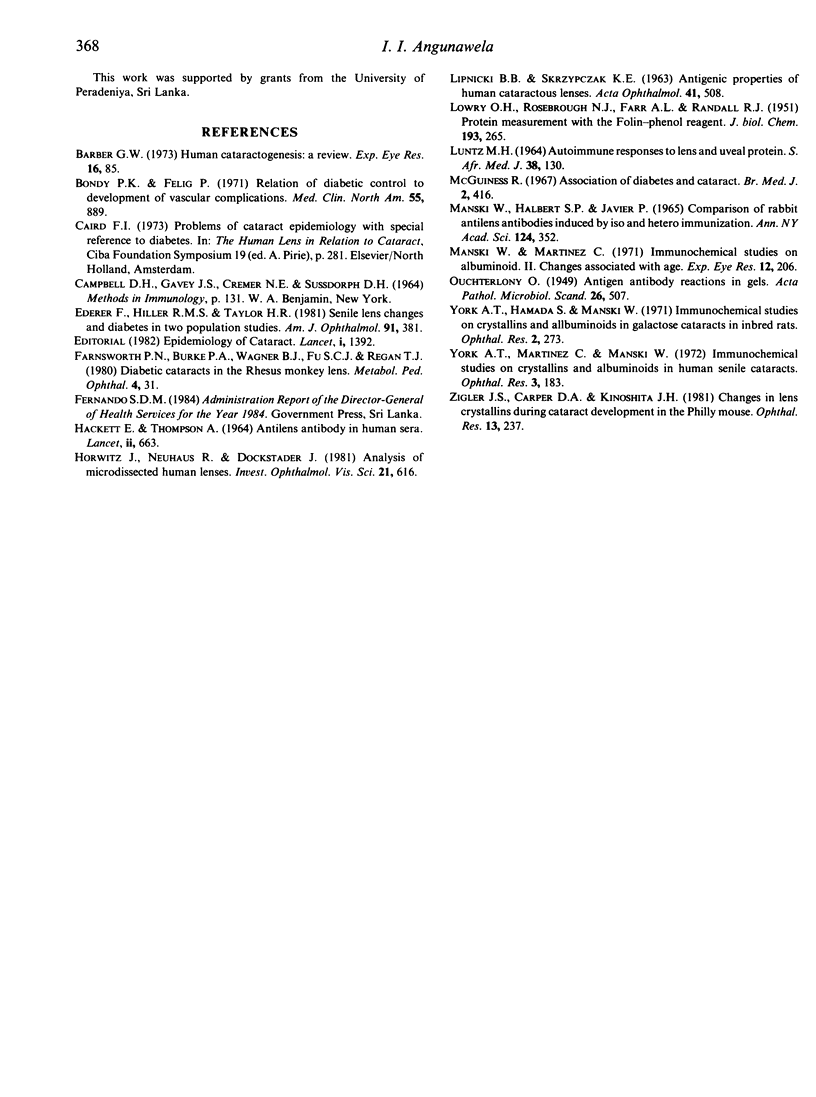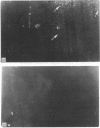Abstract
Investigations were carried out to clarify the role of autoimmune phenomena in the pathogenesis of cataract in the adult human lens. Studies were carried out to determine the presence of serum antibodies to lens protein in patients with senile cataract, in patients with diabetes mellitus with and without cataract, and in healthy adult controls using the interfacial test and the gel-diffusion technique. Non-specific antibodies were removed by adsorption of sera with homogenized rat liver. A high proportion of healthy adults was found to have anti-lens protein antibodies (44.4% by the gel-diffusion method). In contrast, patients with cataract and diabetic patients with no cataract demonstrated double this incidence (82% and 80%), while all diabetic patients with cataract showed the presence of antibodies (P = 0.0002). The possible causes for the development of lens antibodies in normal healthy humans are discussed. Also, the causes for the higher incidence of lens antibodies in patients with cataract and in diabetic subjects with no clinical evidence of cataract are considered in relation to cataract formation. Homogenates of cataractous lenses when investigated revealed the presence of both IgG and IgM immunoglobulins, the former probably to a greater extent. Fluorescent microscopy on cryosections of senile and diabetic cataractous lenses revealed the presence of immunoglobulins within the lens. The antigen in the immune complexes isolated from homogenized cataractous lenses was characterized by the SDS-polyacrylamide gel electrophoresis method. A single band was consistently obtained and the molecular weight of the protein was estimated to be between 35,000 and 40,000. The strong possibility of auto-antibodies to lens protein being of aetiological significance in the pathogenesis of cataract is discussed.
Full text
PDF





Images in this article
Selected References
These references are in PubMed. This may not be the complete list of references from this article.
- Barber G. W. Human cataractogenesis: a review. Exp Eye Res. 1973 Jun;16(2):85–94. doi: 10.1016/0014-4835(73)90303-5. [DOI] [PubMed] [Google Scholar]
- Ederer F., Hiller R., Taylor H. R. Senile lens changes and diabetes in two population studies. Am J Ophthalmol. 1981 Mar;91(3):381–395. doi: 10.1016/0002-9394(81)90293-2. [DOI] [PubMed] [Google Scholar]
- Farnsworth P. N., Burke P. A., Wagner B. J., Fu S. C., Regan T. J. Diabetic cataracts in the rhesus monkey lens. Metab Pediatr Ophthalmol. 1980;4(1):31–42. [PubMed] [Google Scholar]
- HACKETT E., THOMPSON A. ANTI-LENS ANTIBODY IN HUMAN SERA. Lancet. 1964 Sep 26;2(7361):663–666. doi: 10.1016/s0140-6736(64)92477-8. [DOI] [PubMed] [Google Scholar]
- Horwitz J., Neuhaus R., Dockstader J. Analysis of microdissected cataractous human lenses. Invest Ophthalmol Vis Sci. 1981 Oct;21(4):616–619. [PubMed] [Google Scholar]
- LIPNICKI B. B., SKRZYPCZAK K. E. ANTIGENIC PROPERTIES OF HUMAN CATARACTOUS LENSES. Acta Ophthalmol (Copenh) 1963;41:508–514. doi: 10.1111/j.1755-3768.1963.tb03563.x. [DOI] [PubMed] [Google Scholar]
- LOWRY O. H., ROSEBROUGH N. J., FARR A. L., RANDALL R. J. Protein measurement with the Folin phenol reagent. J Biol Chem. 1951 Nov;193(1):265–275. [PubMed] [Google Scholar]
- LUNTZ M. H. AUTO-IMMUNE RESPONSE TO LENS AND UVEAL PROTEIN. S Afr Med J. 1964 Feb 15;38:130–133. [PubMed] [Google Scholar]
- Manski W., Halbert S. P., Javier P. Comparison of rabbit antilens antibodies indused by iso- and heteroimmunization. Ann N Y Acad Sci. 1965 Jun 30;124(1):352–364. doi: 10.1111/j.1749-6632.1965.tb18970.x. [DOI] [PubMed] [Google Scholar]
- Manski W., Martinez C. Immunochemical studies on albuminoid. II. Changes associated with age. Exp Eye Res. 1971 Sep;12(2):206–211. doi: 10.1016/0014-4835(71)90092-3. [DOI] [PubMed] [Google Scholar]
- McGuinness R. Association of diabetes and cataract. Br Med J. 1967 May 13;2(5549):416–418. doi: 10.1136/bmj.2.5549.416. [DOI] [PMC free article] [PubMed] [Google Scholar]





